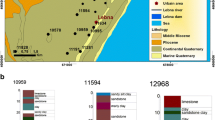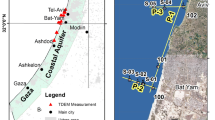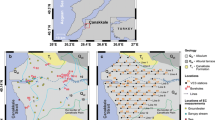Abstract
The study area is a small coastal plain in north-eastern Tunisia. It is drained by an ephemeral stream network and is subject to several pollutant discharges such as oilfield brine coming from a neighboring oil company and wastewater from Somâa city, located in the upstream of the plain. Furthermore, a hydraulic head near the coastal part of the aquifer is below sea level, suggesting that seawater intrusion may occur. A time-domain electromagnetic (TDEM) survey, based on 28 soundings, was conducted in Wadi Al Ayn and Daroufa plains to delineate the saline groundwater. Based on longitudinal and transversal resistivity two-dimensional pseudosections calibrated with boring data, the extent of saline water was identified. Geochemical tracers were combined with the resistivity dataset to differentiate the origin of groundwater salinization. In the upstream part of the plain, the infiltration of oilfield brine through the sandy bed of Wadi Al Ayn seems to have a considerable effect on groundwater salinization. However, in the coastal part of the aquifer, groundwater salinization is due to seawater intrusion and the saltwater is reaching an inland extent around 1.3 km from the shoreline. The contribution ratios of saline water bodies derived from the inverted chloride data vary for the oilfield brine from 1 to 13 % and for the seawater from 2 to 21 %.
Résumé
La zone d’étude est une petite plaine dans le Nord Est de la Tunisie. Elle est drainée par un réseau de cours d’eau éphémères et est soumise à plusieurs rejets de polluants tels que des saumures de champ pétrolier provenant d’une compagnie pétrolière voisine et d’eaux usées de la ville de Somâa, située en amont de la plaine. En outre, la charge hydraulique proche de la partie côtière de l’aquifère est située en dessous du niveau de la mer, suggérant la possible intrusion d’eau salée marine. Une prospection électromagnétique dans le domaine temporelle, basée sur 28 sondages, a été réalisée dans les plaines du Wadi Al Ayn et de Daroufa afin de délimiter les eaux souterraines salées. L’extension d’eau salée a été identifiée à partir de l’élaboration de pseudo-sections bi dimensionnelles de résistivité longitudinale et transversale, calibrées à l’aide de données de forages. Des traceurs géochimiques ont été combinés avec l’ensemble des données de résistivité pour différencier l’origine de la salinisation des eaux souterraines. Dans la partie amont de la plaine, l’infiltration des saumures des champs pétroliers au travers du lit sableux du Wadi Al Ayn semble avoir un effet considérable sur la salinisation des eaux souterraines. Cependant, dans la partie côtière de l’aquifère, la salinisation des eaux souterraines est due à l’intrusion marine et l’eau salée atteint une extension d’environ 1.3 km à l’intérieur des terres depuis le trait côtier. Les rapports de contribution d’eau salée dans les eaux souterraines déduits des données inversées de chlorure varient entre 1 et 13 % pour les saumures des champs pétroliers et entre 2 et 21 % pour l’eau de mer.
Resumen
El área de estudio es una pequeña planicie costera en el noreste de Túnez. Está drenada por una red de cursos efímeros y sujeta a varias descargas de contaminantes tales como salmuera proveniente de un campo petrolífero vecino y de aguas residuales de la ciudad de Somâa, situada agua arriba de la planicie. Además, la carga hidráulica próxima a la parte costera del acuífero está por debajo del nivel del mar, lo que sugiere que puede ocurrir la intrusión de agua de mar. Se llevó a cabo un relevamiento electromagnético en el dominio del tiempo (TDEM), basado en 28 sondeos, en las planicies de Wadi Al Ayn y Daroufa para delimitar el agua salada. Basándose en pseudosecciones bidimensionales longitudinales y transversales de resistividad calibradas con datos de perforaciones, se identificó la extensión del agua salina. Los trazadores geoquímicos fueron combinados con los conjuntos de datos de resistividad para diferenciar el origen de la salinización del agua subterránea. Agua arriba de la planicie, la infiltración de salmuera del yacimiento petrolífero a través de la capa de arena de Wadi Al Ayn parece tener un considerable efecto en la salinización del agua subterránea. Sin embargo, en la parte costera del acuífero, la salinización del agua subterránea es debida a la intrusión de agua de mar y el agua salada está alcanzando un extensión tierra adentro de alrededor de 1.3 km desde la línea de costa. La relación de contribución de los cuerpos de agua salina derivados de los datos invertidos de cloruro varía para la salmuera del yacimiento petrolífero de 1 a 13 % y para el agua de mar de 2 a 21 %.
摘要
研究区为突尼斯东北部一个小的沿海平原。这个平原分布有很多季节性河流,有几条河流排放污染物,如附近石油公司排放的油田卤水及位于平原上游的Somâa市排放的污水。此外,含水层沿海部分附近的水头低于海平面,表明会发生海水入侵。在Wadi Al Ayn平原和Daroufa平原进行了基于28水深点的时域电磁勘查,以深入了解地下咸水。根据经过钻孔资料校准的纵向和横向电阻率二维视剖面,确定了咸水的范围。地球化学示踪剂与电阻率资料集相结合以区分地下水盐化的起因。在平原的上游,油田卤水通过Wadi Al Ayn平原砂质层入渗似乎对地下水的盐化有很大的影响。然而,在含水层的沿海部分,地下水的盐化归于海水入侵,咸水已经入侵到距海岸线大约1.3千米的地方。根据反向氯化物资料得到的咸水体贡献率油田卤水为1-13 %,海水为2-21 %。
Resumo
A área de estudo é uma pequena planície costeira no nordeste da Tunísia. É drenada por uma rede de fluxo efémero e está sujeita a diversas descargas de poluentes, tais como a salmoura de um campo petrolífero vindo de uma empresa de petróleo vizinha e de águas residuais da cidade de Somâa, localizada a montante da planície. Além disso, o nível piezométrico perto da parte costeira do aquífero está abaixo do nível do mar, o que sugere que a intrusão de água do mar pode ocorrer. Para delinear a água subterrânea salina, foi realizada nas planícies de Wadi Al Ayn e Daroufa uma pesquisa eletromagnética no domínio do tempo (TDEM), com base em 28 sondagens. A extensão de água salina foi identificada com base na resistividade de pseudo-secções bidimensionais longitudinais e transversais, calibradas com dados de furos. Traçadores geoquímicos foram combinados com o conjunto de dados de resistividade, para diferenciar a origem da salinização das águas subterrâneas. Na parte montante da planície, a infiltração de água salgada do campo petrolífero através do leito de areia de Wadi Al Ayn parece ter um efeito considerável sobre a salinização das águas subterrâneas. No entanto, na parte costeira do aquífero, a salinização da água subterrânea é devida à intrusão salina e a água salgada está a atingir uma extensão de cerca de 1.3 km para o interior da linha de costa. As taxas de contribuição de massas de água salina derivadas a partir dos dados de cloreto invertidos variam para a salmoura do campo petrolífero de 1 a 13 % e para a água do mar de 2 a 21 %.














Similar content being viewed by others
References
Abdalla OAE, Ali M, Al-Higgi K, Al-Zidi H, El-Hussain I, Al-Hinai S (2010) Rate of seawater intrusion estimated by geophysical methods in an arid area: Al Khabourah, Oman. Hydrogeol J 18:1437–1445
Adepelumi AA, Ako BD, Ajayi TR, Afolabi O, Omotoso EJ (2009) Delineation of saltwater intrusion into the freshwater aquifer of Lekki Peninsula, Lagos, Nigeria. Environ Geol 56:927–933
Appelo CAJ, Postma D (2005) Geochemistry, groundwater and pollution, 2nd edn. Balkema, Amsterdam
Archie GE (1942) The electrical resistivity log as an aid in determining some reservoir characteristics. Trans Am Inst Min Metall Eng 146:54–61
Bauer-Gottwein P, Gondwe BN, Christiansen L, Herckenrath D, Kgotlhang L, Zimmermann S (2010) Hydrogeophysical exploration of three-dimensional salinity anomalies with the time-domain electromagnetic method (TDEM). J Hydrol 380(2010):318–329
Ben Hamouda MF, Gonçalves, Fontes Represas PMM, Carreira PM, Monteiro Santos FA (2010) Water salinity origin at Sousse region (Tunisia): a multi survey approach to the problem. Proceedings of the 21st Saltwater Intrusion Meeting. June 21–26, 2010, Azores, Portugal
Ben Hammouda MF, Tarhouni J, Leduc C, Zouari K (2011) Understanding the origin of salinization of the Plio-Quaternary eastern coastal aquifer of CapBon (Tunisia) using geochemical and isotopic investigations. Environ Earth Sci 63(5):889–901
Ben Moussa A, Bel Haj Salem S, Zouari K, Jelassi F (2010) Hydrochemical and isotopic investigation of the groundwater composition of an alluvial aquifer, CapBon Peninsula, Tunisia. Carbon Evapor 25(3):161–176
Ben Salem H (1992) Contribution a la connaissance de la geologie du CapBon: stratigraphie, tectonique et sedimentologie [Contribution to knowledge of the geology of CapBon: stratigraphy, tectonics and sedimentology]. PhD Thesis, Faculty of Sciences, University of Tunis, Tunisia
Bernd CR, Kreitler CW (1993) Geochemical techniques for identifying sources of ground-water salinization. Smoley, Boca Raton, FL
CCI CapBon (2011) Chambre de Commerce et d’Industrie du CapBon, Tunisia [Trade and Industry Chamber of CapBon, Tunisia]. Available from http://www.ccicapbon.org.tn. Accessed 4 December 2011
Chattouti F (2006) Étude des fluctuations piézomètriques des nappes phréatiques et profondes de la côte orientale du CapBon, N–E de la Tunisie [Study of the piezometric fluctuations of the shallow and deep aquifers of the eastern coastal aquifer of CapBon, NE Tunisia]. MSc Thesis, University of Carthage, Bizerte, Tunisia
Chekirbane A (2013) Interaction between groundwater and saline surface water in alluvial aquifers of ephemeral coastal streams, north-east of Tunisia. PhD Thesis, University of Tsukuba, Japan
Christensen NB, Sørensen KI (1998) Surface and borehole electric and electromagnetic methods for hydrogeophysical investigations. Eur J Environ Eng Geophys 3(1):75–90
Clark ID, Fritz P (1997) Environmental isotopes in hydrology. Lewis, Boca Raton, FL
Colleuil B (1976) Étude stratigraphique et néotectonique des formations néogènes et quaternaires de la région Nabeul – Hammamet (CapBon, Tunisie) [Stratigraphic and neotectonic study of the Neogene and Quaternary formations of the Nabeul – Hammamet region (CapBon, Tunisia)]. PhD Thesis. Nice University, France
Craig H (1961) Isotopic variations in meteoric waters. Science 133:1702–1703
Custodio E (1987) Methods to control and combat saltwater intrusion. In: Custodio E, Bruggeman GA (eds) Studies and reports in hydrology: groundwater problems in coastal areas. UNESCO, Paris, pp 396–433
Danielsen JE, Auken E, Jorgensen F, Sondergaard V, Sorensen KI (2003) The application of the transient, electromagnetic method in hydrogeophysical surveys. J Appl Geophys 53(4):181–198
Duque C, Calvache ML, Pedrera A, Martin-Rosales W, Lopez-Chicano M (2008) Combined time domain electromagnetic soundings and gravimetry to determine marine intrusion in a detrital coastal aquifer (southern Spain). J Hydrol 349(3–4):536–547
Ennabli M (1980) Étude hydrogéologique des aquifères du Nord-Est de la Tunisie pour une gestion intégrée des ressources en eau [A hydrogeologic study of the northeastern aquifers of Tunisia for integrated water resources management]. PhD Thesis, Nice University, France
Ernstson K, Kirsch R (2006) Aquifer structures: fracture zones and caves. In: Krisch R (ed) Groundwater geophysics: a tool for hydrogeology. Springer, Berlin, pp 447–474
Everett M, Meju M (2005) Near surface controlled-source electromagnetic induction: background and recent advances. In: Rubin Y, Hubbard S (eds) Hydrogeophysics. Springer, The Netherlands
Finkl CW Jr (1994) Coastal hazards, perception, susceptibility and mitigation. J Coast Res 12:372 (special Issue)
Fitterman DV, Stewart MT (1986) Transient electromagnetic sounding for groundwater. Geophysics 51(4):995–1005
Freeze RA, Cherry JA (1979) Groundwater. Prentice-Hall, Inc., Englewood Cliffs, New Jersey, p 604
Frohlich RK, Urish DW, Fuller J, O’Reilly M (1994) Use of geoelectrical methods in groundwater pollution surveys in a coastal environment. J Appl Geophys 32:139–154
Goldman M, Gilad D, Ronen A, Melloul A (1991) Mapping of seawater intrusion into the coastal aquifer of Israel by the time domain electromagnetic method. Geoexploration 28:153–174
Herckenrath D, Odlum N, Nenna V, Knight R, Auken E, Bauer-Gottwein P (2012) Calibrating a saltwater intrusion model with time-domain electromagnetic data. Ground Water. doi:10.1111/j.1745-6584.2012.00974
Hudak FH, Wachal DJ (2001) Effects of brine injection wells, dry holes, and plugged oil/gas wells on chloride, bromide, and barium concentrations in the Gulf Coast Aquifer, southeast Texas, USA. Environ Int 26(7–8):497–503
Jemai S (1996) Evolution de l’état de la nappe de Korba: étude hydrogéochimique et modélisation numérique [Evolution state of the Korba aquifer: hydrogeochemical study and numerical modeling]. MSc Thesis, Agronomical National Institute of Tunisia (INAT), Tunisia
Kafri U, Goldman M (2005) The use of the time domain electromagnetic method to delineate saline groundwater in granular and carbonate aquifers and to evaluate their porosity. J Appl Geophys 57(3):167–178
Kafri U, Goldman M, Lang B (1997) Detection of subsurface brines, freshwater bodies and the interface configuration in-between by the time domain electromagnetic method in the Dead Sea Rift, Israel. Environ Geol 31(1–2):42–49
Kaufman AA, Keller GV (1983) Frequency and transient soundings. Elsevier, Amsterdam, p 685
Kerrou J (2008) Deterministic and probabilistic numerical modelling towards sustainable groundwater management: application to seawater intrusion in the Korba aquifer (Tunisia). PhD Thesis, Neuchâtel University, Switzerland
Khlaifi I (1998) Contribution à l'étude de l'intrusion marine par un modèle de transport tridimensionnel: interfaçage avec des systèmes d'information géographique [Contribution to the study of seawater intrusion using 3D solute transport model: interfacing with a geographical information system]. MSc Thesis, University of Tunis El Manar, Tunisia
Kouzana L, Ben Mammou A, Sfar Felfoul M (2009) Seawater intrusion and associated processes: case of the Korba aquifer (CapBon, Tunisia). Compt Rendus Geosci 341(1):21–35
Kouzana L, Benassi R, Ben Mammou A, Sfar Felfoul M (2010) Geophysical and geochemical study of the seawater intrusion in Mediterranean semi arid zones: case of the Korba coastal aquifer (Cap-Bon, Tunisia). J Afr Earth Sci 58(2):242–254
Land LA, Lautier JC, Wilson NC, Chianese G, Webb S (2004) Geophysical monitoring and devaluation of coastal plain aquifers. Ground Water 24(1):59–67
Levi E, Goldman M, Hadad A, Gvirtzman H (2008) Spatial delineation of groundwater salinity using deep time domain electromagnetic geophysical measurements: a feasibility study. Water Resour Res 44, W12404
MacInnes S, Raymond M (2001) STEMINV documentation – Smooth Model TEM Inversion, V.3.00, Zonge Engineering and Research Org., Tucson, AZ
Macnae JC, Lamontagne Y, West GF (1984) Noise processing techniques for time domain EM systems. Geophysics 49:934–948
Maliki MA, Krimissa M, Michelot JL, Zouari K (2000) Relation entre nappes superficielles et aquifère profond dans le bassin de Sfax, Tunisie [Relationship between shallow and deep aquifers in the Sfax basin, Tunisia]. C R Acad Sci 331(1):1–6
McCracken KG, Oristaglio ML, Hohmann GW (1986) The minimization of noise in electromagnetic exploration systems. Geophysics 51:819–832
McNeil JD (1990) Use of electromagnetic method for groundwater studies. In: Ward S (ed) Geotechnical and environmental geophysics. Review and Tutorial, SEG investigations in Geophysics No. 5, vol 1. Tulsa, pp 191–218
Mills T, Hoekstra M, Blohm M, Evans L (1988) Time domain electromagnetic soundings for mapping sea-water intrusion in Monterey country, California. Ground Water 26:771–782
Paine JG (2003) Determining salinization extent, identifying salinity sources, and estimating chloride mass using surface, borehole, and airborne electromagnetic induction methods. Water Resour Res 39(3):1059. doi:10.1029/2001WR000710
Paniconi C, Khlaifi I, Lecca G, Giacomelli A, Tarhouni J (2001) A modeling study of seawater intrusion in the Korba coastal plain, Tunisia. Phys Chem Earth B 26(4):345–351
Paniconi C, Khlaifi I, Lecca G, Giacomelli A, Tarhouni J (2004) Modeling and analysis of seawater intrusion in the coastal aquifer of eastern Cap-Bon, Tunisia. Transp Porous Media 43(1):3–28
Piper AM (1994) A graphic procedure in the geochemical interpretation of water analysis. Am Geophys Union Trans 25:914–923
Rekaya M (1989) Le contexte hydrogéologique de la nappe aquifère de la côte orientale du CapBon (Tunisie) et les problèmes causés par la surexploitation [Hydrogeologic context of the eastern coastal aquifer of CapBon (Tunisia) and its overexploitation problems]. General Direction of Water Resources, Tunis, Tunisia
Rhoades JD, Kandiah A, Mashali AM (1992) The use of saline waters for crop production - FAO irrigation and drainage paper 48. Food and Agriculture Organization of the United Nations, Rome. Available from http://www.fao.org/docrep/T0667E/T0667E00.htm. Accessed in September 2012
Rouatbi R (1968) Étude hydrogéologique primaire de la région Tafelloune, CapBon oriental [A preliminary hydrogeologic study of Tafelloune region, eastern CapBon]. Bureau of Hydraulic Resources Inventory (BIRH), Tunis, Tunisia
Slama F (2010) Field experimentation and modeling of salt transfer in Korba coastal plain: impact of seawater intrusion and irrigation practices. PhD Thesis, Neuchâtel University, Switzerland
Stewart M, Gay MC (1986) Evaluation of transient electromagnetic soundings for deep detection of conductive fluids. Ground Water 24(3):351–356
Stuyfzand PJ (1999) Patterns in groundwater chemistry resulting from groundwater flow. Hydrogeol J 7(1):15–27
Thomsen R, Sondergaard VH, Sorensen KI (2004) Hydrogeological mapping as a basis for establishing site-specific groundwater protection zones in Denmark. Hydrogeol J 12(5):550–562
Trabeslsi F, Ben Mammou A, Tarhouni J, Piga C, Ranieri G (2013) Delineation of saltwater intrusion zones using the time domain electromagnetic method: the Nabeul-Hammamet coastal aquifer case study (NE Tunisia). Hydrol Process 27:2004–2020
Yechieli Y, Kafri U, Goldman M, Voss CI (2001) Factors controlling the configuration of the fresh-saline water interface in the Dead Sea coastal aquifers: synthesis of TDEM surveys and numerical groundwater modeling. Hydrogeol J 9(4):367–377
Zghibi A, Zouhri L, Tarhouni J (2011) Groundwater modelling and marine intrusion in the semi-arid systems (Cap-Bon, Tunisia). Hydrol Process 25(11):1822–1836
Zonge KL (1992) Introduction to TEM. In: Van Blaricom R (ed) Practical geophysics II, for the exploration geologist. Northwest Mining Assoc., Spokane, WA
Acknowledgements
This work was supported by the Science and Technology Research Partnership for Sustainable Development (SATREPS) program, funded by the Japan Science and Technology Agency (JST) and the Japan International Cooperation Agency (JICA), Japan. The authors would also like to thank the anonymous reviewers for their constructive comments.
Author information
Authors and Affiliations
Corresponding author
Rights and permissions
About this article
Cite this article
Chekirbane, A., Tsujimura, M., Kawachi, A. et al. Use of a time-domain electromagnetic method with geochemical tracers to explore the salinity anomalies in a small coastal aquifer in north-eastern Tunisia. Hydrogeol J 22, 1777–1794 (2014). https://doi.org/10.1007/s10040-014-1180-7
Received:
Accepted:
Published:
Issue Date:
DOI: https://doi.org/10.1007/s10040-014-1180-7




